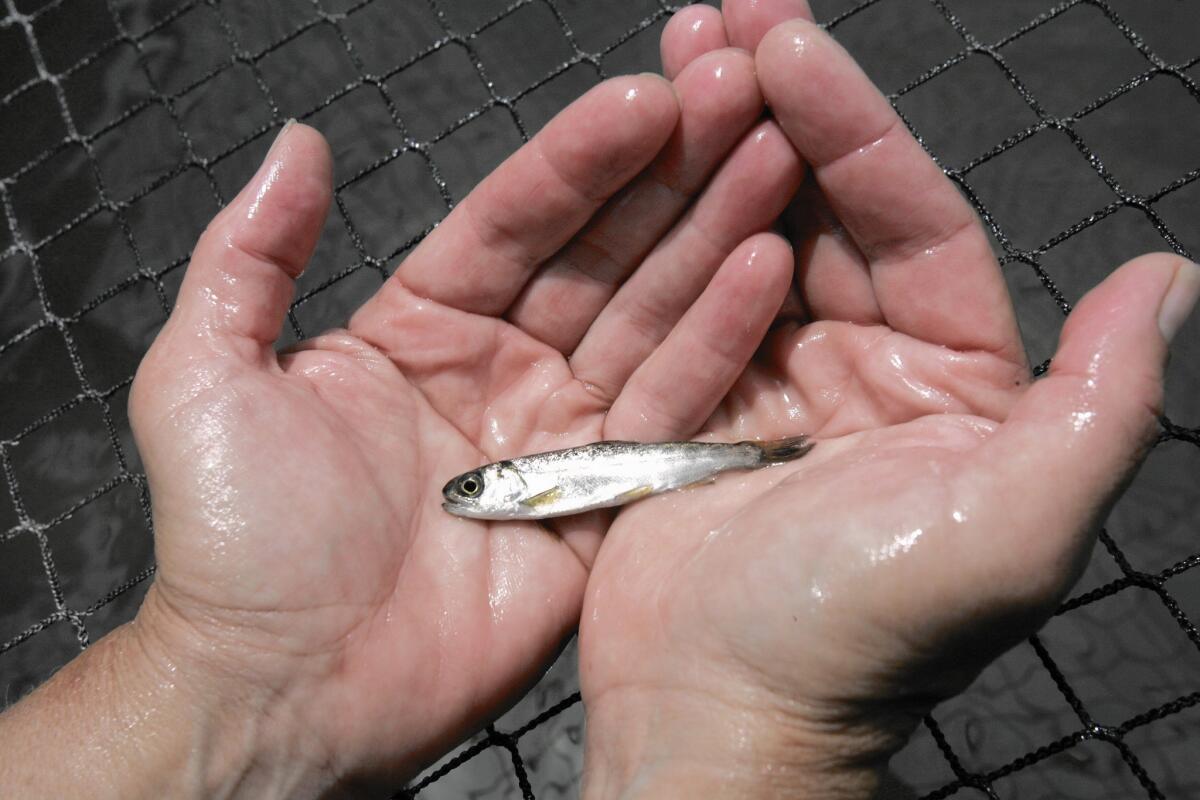Capitol Journal: Let bass off the hook in Gov. Jerry Brown’s delta tunnel plan

In Sacramento — “Summertime, and the livin’ is easy. Fish are jumpin’ and the cotton….” Hold it there. Cotton growers don’t like those fish jumpin’.
Neither do hardly any other growers in the thirsty San Joaquin Valley. Not bass, anyway, jumpin’ in the bucolic California Delta. They want `em dead.
Striped and black bass, so popular with recreational anglers, are trying to survive in water that San Joaquin Valley growers desperately covet for their crops. And the fish are messing it up.
Summertime indeed is easy livin’ in the Sacramento-San Joaquin River Delta, the largest estuary on the west coast of all the Americas and California’s main water hub.
Water flows from the Sierra have slowed, and the rivers, muddy only a few weeks ago, are turning a deep green.
Houseboats and skiffs, ski craft and bass boats are navigating waterways lined with willows, sycamores, vines and oaks. The delta is everyone’s swimming hole. Rustic restaurants and bars are inviting respites.
Anglers anchor in the rivers and toss out bait to tempt stripers. In sloughs, fishermen nose their small boats into reeds and cast lures for black bass.
But it’s all threatened. Gov. Jerry Brown and big interests — corporate agriculture, water districts, labor unions — are trying to convince government environmental regulators that digging two 40-foot-wide, 35-milethan it is. In fact, they argue, it’ll improve.
Sure, the project will disrupt local farming, burgs, marinas and lifestyles. But southbound water deliveries, it’s contended, will become more reliable.
There’s also a financing dilemma, however. The cost is pegged, so far, at a hefty $15.5 billion. That will increase practically everyone’s water bill in the San Joaquin Valley and Los Angeles Basin. Critics say the money could be better spent on regional projects, such as recycling, storm water capture and desalination.
But back to those bad bass.
This is convoluted and a bit concocted, but the charge is that striped bass and black bass eat beautiful baby salmon and endangered tiny smelt. Moreover, the bass aren’t even native Californians, while the salmon and smelt are.
It’s hardly a scientific discovery that big fish eat little fish. Just like big farms in the San Joaquin Valley are trying to crunch little farms in the delta by siphoning off more of their fresh water.
Actually, what adult stripers prefer to eat are their own young. But they’ll eat any critter that swims near, including little salmon and smelt. So will the iconic steelhead trout, but they’re natives so no one is targeting them.
Those herons and egrets, they get hungry too and dip in their beaks, plucking out fish. But nobody’s trying to blow them away.
And the sea lions that swim up from San Francisco Bay in pursuit of spawning salmon and stripers. Don’t get me started on them. They scarf down fish like Alaskan bears. But they’re sacrosanct.
As for being native to California, hardly any crop is. Almonds did start arriving with Spanish explorers in the 1700s. But navel oranges came here about the same time as striped bass did from the East Coast in the 1870s. Cotton was first grown early in the 20th century.
So let’s not get too huffy about what’s native. Certainly people of European ancestry aren’t.
The problem for San Joaquin Valley farmers and the Metropolitan Water District of Southern California is that when endangered salmon and smelt are threatened in the delta, federal judges restrict pumping and reduce flows into southbound aqueducts.
Delta fish populations — most importantly Chinook salmon, which supply the coastal fishing industry, and the shy smelt that live only locally — have been a century ago.
The project has been deadly for fish, chomping them up in giant pumps. The pumps also reverse natural river flows, confusing salmon trying to make it to the ocean.
There are other culprits, too: dams that block access to ancestral spawning streams, a toxic brew of pesticide runoff from farm fields and inadequately treated waste water from cities.
The bass, however, have become scapegoats for big water interests: agriculture, urban districts, contractors, labor unions. They’ve banded together in a speciously named organization called — the Coalition for a Sustainable Delta — that is trying to make it easier for anglers to catch and decimate bass.
They’re petitioning the state Fish and Game Commission — appointed by the governor — to reduce minimum size limits and increase daily catch limits. The size limit for stripers would be lowered to 12 inches from 18 inches to 12, and the daily catch limit raised to six from two to six. For black bass, allowable sizes would be reduced to 8 inches from 12 inches to 8 and the daily creel limit upped to 10 from five to 10.
The coalition calls it an important step toward restoring salmon and smelt, which would stabilize water deliveries for irrigation and cities.
Nonsense, says Peter Moyle, a veteran delta fish biologist at the UC Davis Center for Watershed Sciences.
“People don’t seem to get that striped bass have declined along with the smelt,” Moyle says. “The same thing has been affecting all fisheries. They need a functioning estuary.”
Reducing the striper population, he says, “will make no difference at all. You’ve got all those other predators out there.”
Predators like non-native San Joaquin water gulpers.
Follow @LATimesSkelton on Twitter
ALSO
Don’t blame the smelt: The salmon too reflects the dire state of the California Delta
MWD will try to buy delta islands for water storage, habitat purposes
More to Read
Get the L.A. Times Politics newsletter
Deeply reported insights into legislation, politics and policy from Sacramento, Washington and beyond. In your inbox three times per week.
You may occasionally receive promotional content from the Los Angeles Times.











